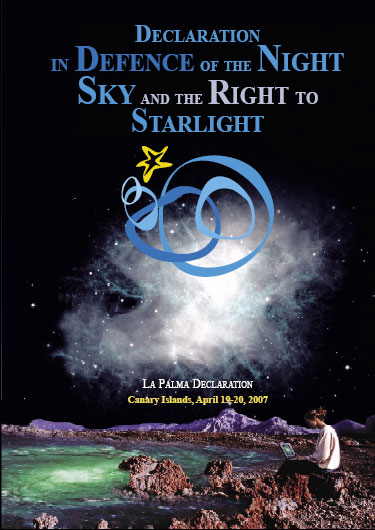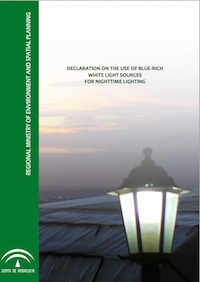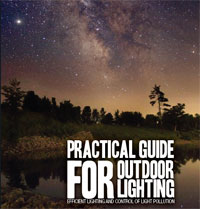International declaration warning about the effects of blue-rich white light
Declaration on the Use of Blue-rich White Light Sources for Nighttime Lighting
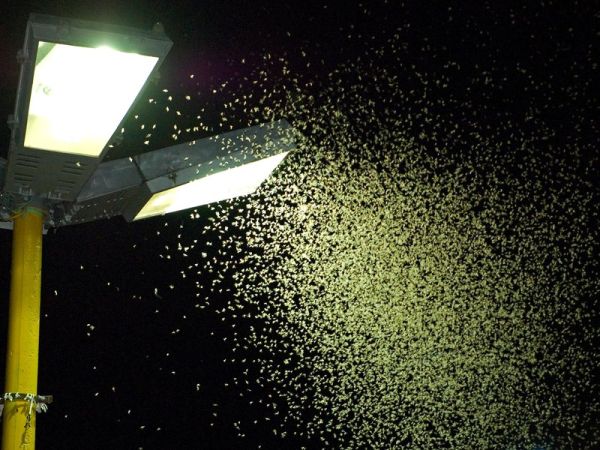
International Group of Experts for the Protection of the Night Sky
Light pollution, defined as the introduction of artificial light into the environment at night, has received increasing attention during the last decades, due to its impact on science, biodiversity, economy and human health. The impact of light pollution on astronomy is obvious, but artificial light at night also affects wildlife, since ecosystems have evolved and adapted to the darkness of night. The same is true for the human species: modern generations have grown up under streetlights, and often forget that light at night is, in biological terms, a very recent invention. We are learning that artificial light at night may pose huge risks for our health. Many solutions have been proposed to deal with the different aspects of light pollution from the point of view of light engineering. But there is growing evidence that most detrimental effects of light at night increase when the light is white or, more specifically, rich in blue (short) wavelengths. For this reason, and given that recent trends in outdoor and indoor lighting are promoting this kind of light, mainly in the form of white light emitting diodes (LEDs), this declaration is being made to warn about the disadvantages of blue-rich artificial light at night. Its contents should also be taken into account in the wider context of light pollution in general.
The scattering of light in the atmosphere is responsible for artificial skyglow at night, the diffusedlight surrounding towns and cities. It happens when light coming from outdoor and indoor lighting systemsinteracts with the molecules of the air and with the particles suspended in it (aerosols). The ratio of usefullight to skyglow depends on fixture design and on the kind of lamps used; on clear nights, blue lightproduces more skyglow than red light. The physical processes (mainly Rayleigh scattering) are stronglycolour dependent, and explain the blue hue of the sky during the day: the blue part of the light comingfrom the Sun is more strongly scattered than the yellow, orange or red light. As a result of thesefundamental physical laws, a key technique to reduce the impact of light at night on astronomy and on thenatural landscape is to use light as yellow-red coloured as possible, avoiding blue-rich sources. Use of bluerichwhite light in the open air at night is harmful for the observation of the night sky. Cool white LEDs areparticularly strong light polluters, due to their strong blue emission peak.
The light halos are visible from cities far away and may affect adjacent sensitive species andecosystems. Many species near the base of the trophic chain, such as nocturnal insects, are mostsensitive to blue-rich light. The effect of lights, whether localized or diffuse, may be fatal, such as for seaturtles or petrels that use natural darkness and starry skies to navigate from their breeding grounds back tothe ocean. Marine organisms are attracted by strong and localized lights, and many fish or cephalopodsare captured by commercial fleets taking advantage of this fact. More subtle effects have also beenreported, such as disorientation of animals. Many behavioral activities are synchronized with lunar cycles.The increase of skyglow from blue-emitting lamps may impair lunar light cycles and affect mating,migration, foraging and other essential activities of organisms in unpredictable ways.
Most natural preserves were not designed or placed to ensure maintenance of ecologicalprocesses without disturbance from artificial lights or skyglow from distant cities. There are few surehavens on the planet where continuing evolution of organisms occurs in non-altered conditions. Theecology of night should be urgently considered in relationship to artificial light in the existing network ofprotected areas, and dark sky reserves are also sorely needed.
Since life formed on our planet, it has developed with a predictable rhythmic environment. Everylife form has evolved in coordination with the day-night cycle, developing the circadian system. Thecircadian system of mammals is synchronised by a deep part of the brain (the suprachiasmatic nucleus ofthe hypothalamus) and several peripheral clocks, passing its temporal signal to the organism viamelatonin, a hormone produced by the pineal gland that peaks at night, with low levels during the day.Light reaches this master clock through a nonvisual pathway consisting of specialised cells in the retina(melanopsin ganglionar cells), that are sensitive primarily to blue light. Their stimulation suppressesmelatonin secretion during the day, and at night if light is present. A growing and increasingly convincingbody of scientific evidence suggests that excessive exposure to bright light at night generates circadiandisruption or chrono-disruption: impairments in the healthy internal temporal order. Evidence points tomelatonin inhibition as the main culprit. Blue light is most effective in melatonin suppression. Longerexposures are required with warmer (yellower or redder) light. Epidemiological studies show that chronodisruptionis associated with increased incidence of metabolic syndrome, cardiovascular diseases,cognitive and affective impairments, premature aging and some cancers such as breast, prostate and colorectal, and with the worsening of pre-existing pathologies. Light cannot be considered harmless. Morespecifically, blue light should be avoided during the night in order to preserve our circadian physiology.
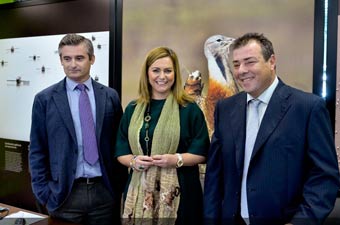 In relation to human vision and artificial lighting, it is noteworthy that the eye’s lens transmits lessblue light as people age, while the transmission of yellow light remains almost constant across all agegroups. Although the dark-adapted human eye is more sensitive to blue light, recommended lighting levelsnow bring vision into the day-time (photopic) regime and, thus, a frequent argument favouring light withhigh blue content fails, unless recommended lighting levels are much reduced. Also, at low lighting levels,warm light is normally perceived as more comfortable than cool light, which produces an aseptic andspectral look in urban places.
In relation to human vision and artificial lighting, it is noteworthy that the eye’s lens transmits lessblue light as people age, while the transmission of yellow light remains almost constant across all agegroups. Although the dark-adapted human eye is more sensitive to blue light, recommended lighting levelsnow bring vision into the day-time (photopic) regime and, thus, a frequent argument favouring light withhigh blue content fails, unless recommended lighting levels are much reduced. Also, at low lighting levels,warm light is normally perceived as more comfortable than cool light, which produces an aseptic andspectral look in urban places.
Light pollution poses a major challenge to modern societies. Its effects worsen with the use ofblue-rich light for lighting at night, both indoors and outdoors. Many aspects converge to make of blue-richlight a resource that must be carefully and sparingly used, and very carefully controlled. Wildlife andecosystems, human health, and the natural nocturnal landscape are all threatened by blue-rich light. Forthese reasons we warn against the recent trends favouring widespread use of white light (unless coupledwith a simultaneous great reduction of lighting levels). We recommend restricting blue light at night, andusing warm, yellow-hued light whenever possible. Spectral criteria should be introduced into outdoorlighting regulations, restricting the use of blue-rich light. Although some blue-rich sources offer efficaciesthat make them attractive from an energy standpoint, warmer light sources now have very similarefficacies, and much lower environmental impact. The design of modern lighting systems should not relyonly on engineering or energy-saving considerations; environmental considerations must also beaddressed, adapting not only lighting direction and intensity to the use of the areas, but also the spectraldistribution of the light. Lamps that emit more energy in the blue than standard high-pressure sodiumlamps should not be installed outdoors. Technological solutions, both classical (sodium) and solid-state(amber LED, filtered white LED), provide warm, less harmful light with excellent energy efficiency. Theseproducts, should be required by authorities, and specified by engineers and designers, to preserve anighttime environment that is friendly to the sky, to nature and to ourselves.
On the basis of the above, the following minimum prescriptions should be used together to limitlight pollution:
- Do not allow luminaires to send any light directly at and above the horizontal.
- Do not waste downward light flux outside the area to be lit.
- Avoid over lighting and redefine the lighting levels for road lighting, lowering them substantially.
- Shut off lights when the area is not in use.
- Aim for a decrease of the total installed flux (in the same manner as other pollutants are beingreduced)
- Strongly limit the short wavelength blue light.
EXPERT INTERNATIONAL GROUP WHO DREW UP THE DECLARATION (*):
Ángela Ranea Palma (Service for Air Quality, Ministry for the Environment and Territory Management of the Regional Government of Andalusia, Spain).
Estefanía Cañavate García (Agency for the Environment and Water of Andalusia, Spain).
María de los Ángeles Rol de Lama (Chronobiology Laboratory, University of Murcia, Spain).
David Galadí Enríquez (German-Spanish Astronomical Centre, Calar Alto Observatory, Spain).
Juan José Negro Balmaseda (Doñana Biological Station –CSIC-, Spain).
Richard Wainscoat (University of Hawaii, United States).
Fabio Falchi (ISTIL – Light Pollution Science and Technology Institute, Italy).
Javier Díaz Castro (Technical Office for the Protection of the Sky, Canary Islands Astrophysical Institute IAC, Spain).
Manuel García Gil (Polytechnical University of Catalonia, Spain).
Andreas Hänel (Schölerberg Planetarium and Museum of Nature and the Environment, Osnabrück, Germany).
Carlos Herranz Dorremochea (Cel Fosc, Spanish Dark Sky Association).
Fernando Jáuregui Sora (Pamplona Planetarium)
Cipriano Marín (Coordinator of the Starlight Initiative / UNESCO Center of the Canary Islands)
Friedel Pas (Preventie Lichthinder vzw, Belgium. European Liaison Officer of the International Dark-Sky Association, IDA).
Pedro Sanhueza Pérez (Technical Office for the Protection of the Sky in Northern Chile).
(*)This Declaration reflects the opinions and ideas of the authors and does not necessarily represent the official stance of the institution to which they belong.
Junta de Andalucía oficial web site
Public presentation of the Declaration
| < Prev | Next > |
|---|
LOOKING FOR SOMETHING?


Starlight Initiative collaborates with the
PORTAL TO THE HERITAGE OF ASTRONOMYUpdates
- New Brochure of UNESCO`s MAB Programme partnership
- Galicia adopts the Starlight Declaration
- Starlight at the 39th session of the World Heritage Committee
- International declaration warning about the effects of blue-rich white light
- Flyer - Starlight Initiative in partnership with the UNESCO MAB Programme
- Astronomical Heritage - Hawaii 2015
- 2015 International Year of Light
- Montsec - Starlight Destination and Reserve
Starlight Finder
Starlight related links
![]()
Covenant of Mayors Related Initiative
![]()
Colaborating with IAU Working Group
![]()
IUCN Dark Sky Advisory Group
![]()
Dark Skies Awareness Project
![]()
Partnership Unesco-MaB
![]()
Member of the Knowledge Network
![]()
Instituto de Astrofísica de Canarias
|
The Starlight Initiative is designed as an international action in defence of the values associated with the night sky and the general right to observe the stars. It is open to the participation of all scientific, cultural, environmental, and citizens' organizations... |
In partnership with: |
|
|
|
